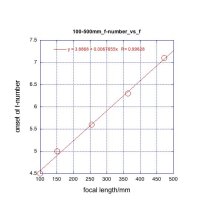Never mind all the numbers silliness, does it take good 'pitchers'?
Dem pitchers is all I cares about ya knows.
Do yer pitchers have enough megapickles?
Upvote
0
Never mind all the numbers silliness, does it take good 'pitchers'?
Dem pitchers is all I cares about ya knows.
Is there such a thing?Do yer pitchers have enough megapickles?
Hopefully, Canon makes it easy to switch between 1/3 and 1/2 increments when using the Canon RF 100-500mm f/4.5-7.1L IS USM with your EOS R5 & EOS R6.
Do yer pitchers have enough megapickles?
Queue Tony and Chelsea complaining about this very thing in their next video.

All this suggests to me that the 1/3rd stops are more realistic, and the 1/2 stops are just numbers spewed out by Canon to be ones we are used to seeing, like 5.6, and aren't real.
Where would a coarser-grained approximation be better for some focal lengths? A genuine question, I realise that a clock that is stopped is absolutely correct twice a day but one that is 1 minute fast never is never right.Both the 1/3 and the 1/2 stop scale are approximations. The lens is almost certainly physically not exactly 100–500mm f/4.5–7.1, those are just familiar figures that the actual physical values are rounded to. At least at some focal lengths the 1/2 scale may actually be a better approximation, but 1/3 happens to be the one that most people use and is, of course, the more fine-grained of the two.
If it works the same way on the R5 and the R6 as on current Canon cameras it won‘t be hard to change From 1/2 to 1/3 increments if you read the manual.It would be nice if Canon finally released the manuals of the R5 and R6. Do they expect people to order those camaras without having read the manual? Then we would know how easy it is to change from 1/2 to 1/3 increments and back.
The difference between 1/3 stop and 1/2 stop is 1/6 stop, which isn‘t all that much.Where would a coarser-grained approximation be better for some focal lengths? A genuine question, I realise that a clock that is stopped is absolutely correct twice a day but one that is 1 minute fast never is never right.
Given that the apparent aperture size varies continuously and smoothly as a function of the focal length, there’s necessarily a point where, say, f/6.7 (the half step between 5.6 and 8) is a better approximation of the real aperture ratio than either f/6.3 or f/7.1. But of course differences of just 1/6 stops are mostly academic anyway.Where would a coarser-grained approximation be better for some focal lengths? A genuine question, I realise that a clock that is stopped is absolutely correct twice a day but one that is 1 minute fast never is never right.
The difference between reported values of f/5.6 and f/6.3 at 400mm is a 1/3 stop so how does a 1/6 stop account for that?The difference between 1/3 stop and 1/2 stop is 1/6 stop, which isn‘t all that much.
Here it is again as it is most pertinent.
View attachment 191338
If the lens is reporting f6.3 using 1/3 stop increments the actual measurement has to be closer to f6.3 than to f5.6. If same lens is reporting f5.6 using 1/2 stop increments, the actual measurement has to be closer to f5.6 than to f6.7, or whatever the half stop value is. So, for the lens to read F5.6 using half stop increments and read f6.3 using 1/3 stop increments, the actual measurement has to be between (half the difference between f5.6 and f6.3) and (half the difference between f5.6 and f6.7). Dividing a stop into twelfths the actual difference has to between (1/2 (4/12)) stops and (1/2( 6/12)) stops or between 2/12 and 3/12 stops above f5.6. So, the max discrepancy resulting from the lens reading f5.6 with half stop increments and reading f6.3 with third stop increments would be a a twelfth of a stop. (Not a sixth of a stop I said previously.)The difference between reported values of f/5.6 and f/6.3 at 400mm is a 1/3 stop so how does a 1/6 stop account for that?
